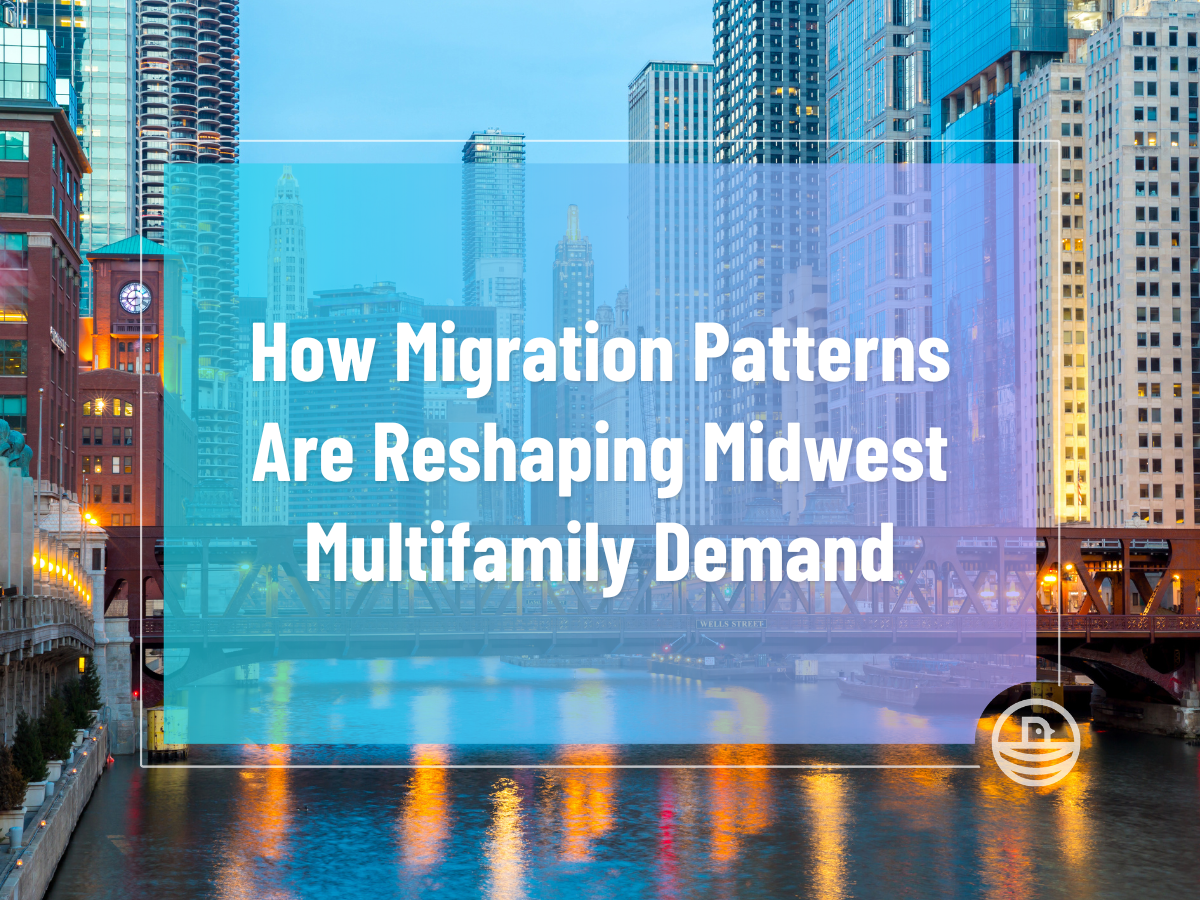Whether you’re talking about birds in the fall or Americans in the twenty-first century, the term “migration pattern” typically evokes movement towards the South. This autumn, however, Americans are breaking with their feathered friends and flocking to a region better known for snow than sunshine.
In a surprise twist, the Midwest has emerged as 2025’s new relocation hotspot, and current migration patterns are reshaping real estate markets across the region. Shifting priorities, evolving work norms, and affordability challenges elsewhere are suddenly driving population growth in places where it has notoriously declined for decades. This demographic movement is transforming both the urban landscape and housing market fundamentals in many Midwestern cities.
These changing tides near the shores of the Great Lakes are having an especially profound impact on multifamily rental (MFR) demand, and investors have begun to take note. MFR investors who only a year ago were looking to Sun Belt markets are now directing capital to the Snow Belt instead. The Midwest’s market fundamentals for MFRs are strong going into 2026, and the factors driving current trends warrant a closer look.
Migration Trends: The Midwest Resurgence
After decades of outflow, the Midwest is emerging as a net gainer in population. North Dakota, Nebraska, and Minnesota stand out for their recent population increases, growing by .95%, .89%, and .72% in 2024, respectively. Even long-suffering states like Ohio, Michigan, and Illinois are now seeing trends of population decline begin to turn around.
Regional changes in population growth are being fuelled almost exclusively by domestic and international migration. Although “natural growth” (births outnumbering deaths) remains positive in most states, it has dwindled considerably and in some places even reversed. Therefore, interest in relocating to Midwestern states is key, and recent data show that the region is only becoming more attractive. Wisconsin saw a whopping 79% increase in inbound move searches and Minnesota jumped from No. 40 to No. 14 in migration interest in a single year. In one recent survey, the Midwest was the only region apart from the South with a net gain in interested movers, posting a > 3% gap between inbound and outbound migration interest in 2025. International migration has also returned as a key driver, with the Midwest gaining over 400,000 new residents via immigration in recent years.
How Migration Drives Multifamily Demand
The droves of newcomers arriving in Midwestern cities have started to put pressure on MFR markets. Influxes of residents have meant surging demand for rentals, particularly in gateway cities like Chicago, Minneapolis, and Detroit, as well as in college towns and secondary metros such as Columbus and Des Moines. Consequently, Midwestern cities have seen some of the fastest rent increases in the country. Cleveland leads the pack with a 5.1% jump in rent prices year-over-year.
National developers and local investors are responding with large numbers of new multifamily building projects. For instance, Columbus is one of the top five U.S. cities issuing the most multifamily building permits in 2025. Des Moines, meanwhile, has seen a staggering increase in the pace of new multifamily construction with 743% more multifamily building permits issued compared to last year. This push to create new inventory is particularly noteworthy given that construction is cooling off in many other regions. Also noteworthy is the fact that in many places these new construction deliveries are expected to have minor effects on vacancy rates and virtually no effect on rental rate growth.
Socioeconomic Drivers and Shifting Preferences
Clearly, there are plenty of people who have begun to see their future in the Midwest, but it begs the question: why now?
There are several reasons, but affordability tops the list. Buyers and renters alike are increasingly being priced out of exorbitant coastal housing markets and left searching elsewhere. Even some markets in the South have become more expensive and / or volatile as they’ve experienced huge spikes in population. As the governor of New York put it, “the obscenely high costs of rents and mortgages” in traditional growth hubs are now driving people away from them.
Policy shifts, national economic currents, and climate change are factoring into movers’ decisions as well. Cities in the Midwest are prioritizing balance in their housing stock with policies that ensure adequate workforce housing and affordable units. Many Midwest states also benefit from strategic investments in infrastructure, education, and job retraining, making them doubly attractive for families and young professionals searching for attainable housing and upward mobility. Plus, northern Midwestern states are especially well-insulated from the worst effects of climate change. Extreme weather in the region tends to mean lots of snow and sub-zero temperatures as opposed to wildfires and hurricanes. If anything, higher average temps are only making the region more livable.
Finally, the shift to remote and hybrid work models has given more households the freedom to prioritize lifestyle and community. A recent survey conducted by the National Association of Realtors found that the most common reason for moving is to be closer to friends and family. As job opportunities become less restricted to a handful of major cities, people are beginning to prioritize work-life balance and the ability to spend time with loved ones. The affordability and strong community focus of the Midwest is highly conducive to those values.
Midwest Markets to Watch
Cities experiencing the sharpest gains tend to be those with a mixture of affordable rents, solid infrastructure, and vibrant communities. Here are some of the standout cities that investors are keeping their eyes on as 2025 draws to a close:
Chicago: The Grande Dame of the region is having quite the moment with vacancy rates at 5%, rent growth between 3.8% and 5.5% in its various sub-markets, and huge increases in multifamily sales in both the city proper and wider metro area.
Cleveland: Cleveland is leading the region with the largest overall rental rate increase at 5.1% YoY.
Columbus: Buzz around expansion of the city’s semiconductor manufacturing sector and its strong existing employment base are attracting investors with stability and upside potential.
Des Moines: The city’s population has increased by 6% since 2020 putting pressure on existing rental inventory and spurring major investment in multifamily construction.
Detroit: Motown has been putting up solid numbers for rent increases at 2.9% YoY and received glowing praise for its infrastructure and community investment projects.
Kansas City: Rental rates have risen 3.6% in the last year and are projected to increase by another 3% next year despite a marked increased multifamily inventory.
Minneapolis: The Twin Cities lead the Midwest region in multifamily sales transactions for 2025.
Outlook: What’s Next for Midwest Multifamily?
With net domestic migration projected to remain positive for much of the region, the multifamily outlook in the Midwest is bright.
Many Midwestern cities are thriving by providing solutions to the problems that are driving people away from other regions of the country. Developers are responding to the mushrooming population and demand for economic, community-centered options by prioritizing workforce and affordable housing in addition to luxury multifamily units. Investors and policymakers alike are focusing on new lending practices, incentives, and public-private housing partnerships to address both supply shortages and affordability gaps.
The Midwest focus on sustainable, community-oriented growth reflects broader cultural shifts in values, priorities, and lifestyle preferences, positioning the region to become an even more attractive relocation option in the coming years. Long-term, the migration-driven shakeup in Midwest markets is likely to keep the region’s multifamily sector outperforming the national average on occupancy and rent growth well into 2026 and beyond.


